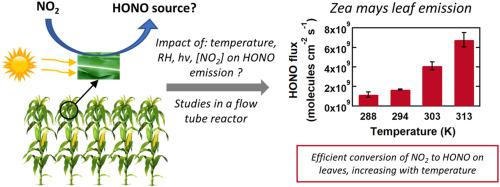Environmental Research ( IF 7.7 ) Pub Date : 2020-11-27 , DOI: 10.1016/j.envres.2020.110543 Aurélie Marion , Julien Morin , Adrien Gandolfo , Elena Ormeño , Barbara D'Anna , Henri Wortham

|
Nitrous acid (HONO) is of considerable interest because it is an important precursor of hydroxyl radicals (OH), a key species in atmospheric chemistry. HONO sources are still not well understood, and air quality models fail to predict OH as well as HONO mixing ratios. As there is little knowledge about the potential contribution of plant surfaces to HONO emission, this laboratory work investigated HONO formation by heterogeneous reaction of NO2 on Zea mays. Experiments were carried out in a flow tube reactor; HONO, NO2 and NO were measured online with a Long Path Absorption Photometer (LOPAP) and a NOx analyzer. Tests were performed on leaves under different conditions of relative humidity (5–58%), NO2 mixing ratio representing suburban to urban areas (10–80 ppbv), spectral irradiance (0–20 W m−2) and temperature (288–313 K). Additional tests on plant wax extracts from Zea mays leaves showed that this component can contribute to the observed HONO formation. Temperature and NO2 mixing ratios were the two environmental parameters that showed substantially increased HONO emissions from Zea mays leaves. The highest HONO emission rates on Zea mays leaves were observed at 313 K for 40 ppbv of NO2 and 40% RH and reached values of (5.6 ± 0.8) × 109 molecules cm−2 s−1. Assuming a mixing layer of 300 m, the HONO flux from Zea mays leaves was estimated to be 171 ± 23 pptv h−1 during summertime, which is comparable to what has been reported for soil surfaces.
中文翻译:

实验室中二氧化氮的异质反应在玉米叶上形成亚硝酸
亚硝酸(HONO)引起人们极大的兴趣,因为它是羟基自由基(OH)的重要前体,后者是大气化学中的关键物种。对HONO的来源仍知之甚少,空气质量模型无法预测OH以及HONO的混合比。由于对植物表面对HONO排放的潜在贡献的了解很少,该实验室工作研究了NO 2在玉米上的异质反应形成HONO的过程。实验是在流管式反应器中进行的。使用长径吸收光度计(LOPAP)和NOx分析仪在线测量HONO,NO 2和NO。在不同的相对湿度(5%至58%),NO 2条件下对叶片进行测试代表郊区与城市的混合比(10至80 ppbv),光谱辐照度(0至20 W m -2)和温度(288至313 K)。对来自玉米叶的植物蜡提取物的其他测试表明,该成分可以促进观察到的HONO形成。温度和NO 2混合比是两个环境参数,表明玉米叶中HONO排放量显着增加。对于40 ppbv的NO 2和40%RH,在313 K下观察到玉米叶上的最高HONO排放速率达到(5.6±0.8)×10 9分子cm -2 s -1。假设混合层为300 m,估计夏季玉米叶的HONO通量为171±23 pptv h -1,与土壤表面的报道可比。











































 京公网安备 11010802027423号
京公网安备 11010802027423号